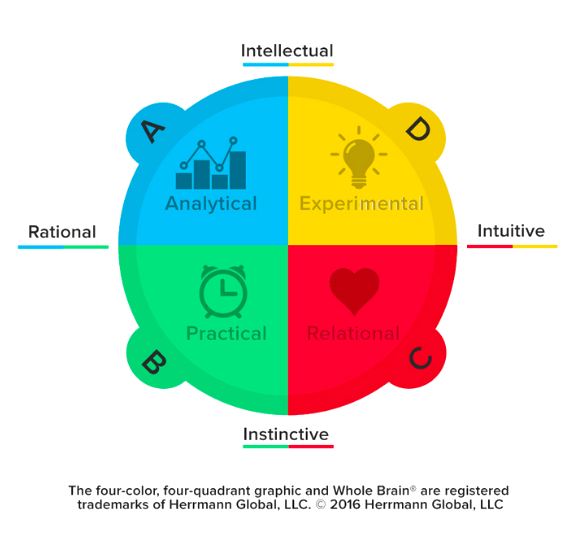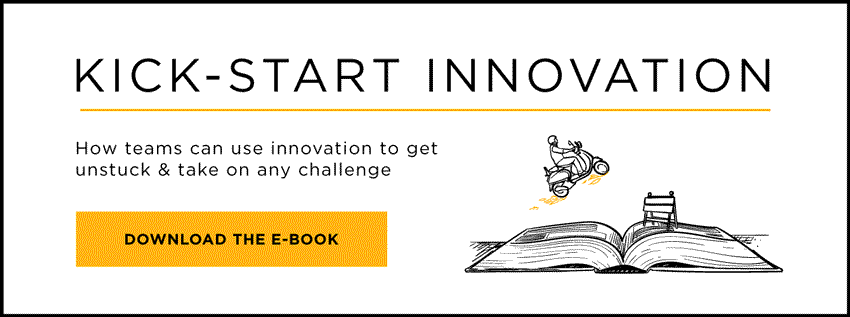In a corporate environment, people who are passionate and enthusiastic can often be dismissed as too emotional — but these “red-quadrant” thinkers are vital to the innovation process.
When teams come together it is very easy for a single voice to dominate the conversation. These “leaders” may be determined by rank — or by whomever has the confidence to speak up where others hesitate. Regardless of how they emerge, they can shape the culture of a team. It’s the natural evolution of team dynamics, but if leaders are cognizant of the rest of the team, others can easily be drowned out or ignored.
In my last post we talked about the importance of having diversity of thought on a team, which means you have a balance of analytical thinkers, planners, risk takers and brain-stormers. I like to use Hermann Solutions’ Whole Brain thinking model to define the thinking styles within team dynamics, which organizes these thinkers into blue, green, yellow and red categories respectively.

When leaders consciously combine all four thinking types on a team it makes that team more adaptable and innovative, able to attack problems from all sides. Where red and green thinkers might focus on numbers, facts, and real world applications, yellow and red thinkers may be more focused on generating big ideas, and empathizing with the customer to find new insights that take the solution in new directions.
However, the benefits of diversity of thought are immediately lost if one of these thinking types dominates decision-making. In these cases, the team may end up with overly practical, incremental solutions that are cost-effective but unimaginative — or fantastic ideas that are brilliant in theory but aren’t rooted in the reality of the business goal. It’s only when they work together, and allow everyone to be heard that truly innovative ideas can emerge.
When I put groups through the Whole Brain assessment to help them identify their dominant thinking quadrant, they often dismiss the idea that they could be red thinkers because this group is typically defined as emotional, passionate and empathetic — traits that can sound too touchy-feely for a business environment. But in fact, these passionate thinkers are often superstars in an innovative culture, and the cornerstone of any good design thinking team.
Design thinking is all about putting customers at the center of decision-making and letting their needs dictate the creative direction – that is not something you can achieve with analytics alone. People who are passionate and empathetic are best able to get into the heads of customers in a way that analysts and planners cannot. That’s where red thinkers add real value.
Leaders Must be Advocates
It is the job of a team to advocate for everyone on the team, to be sure each person has the opportunity to contribute to the solution and add value to the process. This heightens the functionality of the team and creates a better and fruitful team dynamic.
Some ways leaders can do that include:
-
Gathering feedback from everyone before making a decision.
-
Celebrating the contributions of different people, highlighting how their approach to problem-solving brought unique value to the project.
-
Putting different people in charge of different tasks based on their dominant traits — i.e. blues analyze data, greens build a project plan, yellows craft a prototype, and reds talk to customers.
-
Pairing different thinkers together so they can learn from each other and leverage their combined skills to deliver results.
-
Dividing up the work based on team members’ abilities and preferences.
-
Letting different members lead meetings and set agendas to ensure everyone has an opportunity to showcase their thinking about the project and to share their ideas in a respectful space.
Having diversity of thought on a team is vital to the innovation process, but it only works if everyone has a voice. So the next time you are on a team, advocate for those thinkers who aren’t being heard.
Learn how to enable innovation skill-building at scale or download our free ebook Kickstart Innovation: A Guide for Organizations.
Kimberly Douglas, SHRM-SCP, CPF, is President of FireFly Facilitation, Inc., and is a nationally recognized strategic planning, team effectiveness, and innovation expert. Over the past 25 years, she has collaborated with hundreds of leaders — at organizations such as Coca-Cola, Home Depot, McKesson, AT&T, and even the U.S. Marine Corps — to dramatically improve their business performance. A SHRM Senior Certified Professional and a Certified Professional Facilitator, Kimberly also holds a Master of Science in industrial/organizational psychology. Prior to founding FireFly seventeen years ago, Kimberly was an organization effectiveness manager for Coca-Cola; a Director of Consulting with the Hay Group; and served in HR leadership roles in the hospitality, telecommunications, and healthcare industries.
